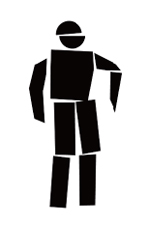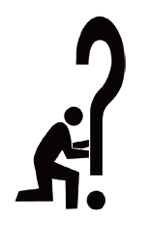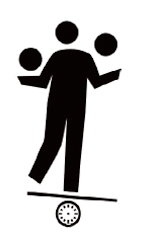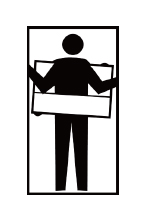There is an old story of a man riding very fast on a horse. As he rides past his friend standing on the side of the road, the friend yells, “Where are you going?” The rider turns toward his friend and yells, “I don’t know, ask the horse!”

The pace and intensity of our lives, both at work and at home, leave many of us feeling like the person riding that frantically galloping horse. Our incessant busyness—too much to do and not enough time; the pressure to tick off items on our to-do list by each day’s end—seems to decide the direction and quality of our existence. But if we approach our days in a different way, we can consciously change this out-of-control pattern. It only requires the courage to do less.
This may sound easy, but doing less can actually be very hard. Too often we mistakenly believe that doing less makes us lazy and results in a lack of productivity. Instead, doing less helps us savor what we do accomplish. We learn to do less of what is extraneous and engage in fewer self-defeating behaviors, so we craft a productive life that we truly feel good about.
As the CEO of an executive coaching and consulting company, I am certainly not immune to the pressures of balancing work, family, and relationships. Since I am also a Zen priest, I have spent much of the past 25 years exploring how to apply Zen practices to work and relationships, as well as how to apply work and relationships to Zen practice. Recently I have organized some of my insights about productivity and well-being into a five-step practice. “The Less Manifesto,” as I call it, focuses on engaging less in five self-defeating habits in order to experience more ease, more composure, and better results in our own lives and in our relationships with others.
I have compressed each of the five habits into one word—one behavior or activity we can do less of—but each represents a huge arena of human emotion and psychology. The list is inspired by the traditional five hindrances of Buddhism, but I have adapted it to the day-to-day challenges I observe in working with clients. The activities or categories are these: fear, assumptions, distractions, resistance, and busyness.
Engaging in any of these habits can be debilitating, leading us to do more and accomplish less. They are often related or intertwined, creating patterns of self-defeating behavior that contribute to unhappiness and dissatisfaction. In each of the five sections on the following pages, I outline one of these counterproductive habits and provide some explorations that may help change it. Experiment with my suggestions and tailor them to your own life.
If we don’t address and change these behaviors, we will always find it hard to accomplish what we want in a way that’s satisfying, no matter how hard we try. But once we change our behaviors, we may find it is possible to do much more than before—and enjoy it.
1. FEAR

Fear can be a useful ally. It can focus us, keep us safe, even keep us alive. Fear of illness or injury can motivate us to stop smoking, to exercise, and to eat healthier food. In our communities, fear can motivate us to make our air and water cleaner, our bridges and levees stronger, our workplaces safer.
Fear can also be an enormous hindrance. It can color our world so that a rope appears as a dangerous snake or an offer of friendship is perceived as an imposition or even an attack. We can fear not getting promoted or losing our jobs, fear what people think about us, or fear that people aren’t thinking at all about us. The list of possible fears is almost endless, so it is not surprising that, sometimes without our knowing it, our actions and decisions can become ruled by fear.
When we are afraid, our first impulse is to tighten our bodies and shut down our minds. We are no longer receptive and playful, which becomes an enormous hindrance to learning new skills in the workplace, to collaborating, and to making interpersonal connections.
Try this:
Invite your fears to tea
Begin by naming your top five fears. Write each one on a piece of paper. If so inclined, you can actually make a pot of tea and fill a cup for each of your fears. When we acknowledge and open up playfully to our fears, they tend to lose their influence and power.
Play with your perception of time
Spend some time every day outside of usual “clock time”—in meditation, with mindfulness practice, or by taking a walk in the park, for example. These practices can act as antidotes to the fears we hold about not having enough time.
Practice generosity
Generosity is an antidote to fear. When you practice being generous with your time, your joy, and your spirit, fear loosens its grip. In fact, finding composure and acting with clarity and resolve, right in the midst of your fears, is a form of generosity that in Buddhism is sometimes referred to as “giving the gift of fearlessness.”
2. ASSUMPTIONS

We are always making predictions and assumptions. When walking down stairs, we trust that the next steps will be there. When driving a car, we make hundreds of assumptions about the functioning of our car and the behavior of other drivers. To function in everyday life, we are required to make assumptions about the causes of events and what will happen next. But predictions and assumptions are often wrong.
For instance, many years ago when I was a young Zen student living at Green Gulch Farm in California, a problem arose among the residents: a sliding wooden door at the entrance of the student living area was regularly being left open. As a result, cold Pacific Ocean winds would sweep in and chill our shared living space. Announcements were made at least a half dozen times at community work meetings reminding people to keep this door shut. But it was continually found open, and over time this became a remarkably divisive issue. People grew emotional, blaming and pointing fingers. In the midst of one tense meeting, Sierra, the farm’s pet golden retriever, opened the door from the outside and joined the group. Of course, Sierra didn’t close the door behind her. Everyone laughed. No one knew that Sierra had the dexterity to open a sliding wooden door. The group’s false assumptions had nearly led to an all-out battle.
Admittedly, this story has a comical ending. It’s a rare case when we can actually blame the dog for our incomplete homework or anything else. But the story does point to a lesson about assumptions: When things go wrong and conflict ensues, the fastest and most effective solution is often to identify and let go of any false assumptions.
Try this:
Ask for feedback
Vietnamese Zen teacher Thich Nhat Hanh suggests that we ask our loved ones, “Please tell me. How can I love you better?” Try asking this of your partner, children, or parents, and then listen to what they say. At work, try asking people you trust, “How can I be a better team member?” or “How can I be better at my job?” Soliciting feedback—and then paying careful attention to it—is a good way to reduce assumptions.
Distinguish motivation from impact
Notice how often you assume what someone else’s motivations are. Much of the time we don’t even know our own motivations, so it can be very difficult to know the motivations of others. But we can be aware of the impact that their actions have within us. Knowing your feelings and emotions and distinguishing these from others’ motivations is an important step in reducing assumptions.
Make requests and offers
Experiment with making clear requests of others. Try beginning sentences with “I request that…” or “Would you please…?” Also make clear offers, such as “Can I help you with…?” By making requests and offers, we increase clarity and connection.
3. DISTRACTIONS

Distractions and interruptions are such a part of modern life that we don’t often realize how hard it is to concentrate. Many neuroscientists, psychologists, and technology pundits believe that the distractions of our communication technology are actually rewiring the brain’s capacity to concentrate for any amount of time on one topic. For example, in a much-discussed 2008 article in The Atlantic (“Is Google Making Us Stupid?”), Nicholas Carr, one of the leading thinkers on information technology, writes, “What the Net seems to be doing is chipping away my capacity for concentration and contemplation. My mind now expects to take in information the way the Net distributes it: in a swiftly moving stream of particles.”
In the age of cell phones and the Internet, many of us have become smitten with the distractions of choice— texting, instant messaging, twittering, listening to iPods, checking email, reading the news online. These distractions can be fun, and, when seen as multitasking, even necessary. The problem is that some distractions are more detrimental to our focus and happiness than others. Most distractions fall into one of two categories: those that draw us in multiple directions at once, resulting in confusion and an inability to complete a thought or action, and those that provide mental relaxation, offering small “breaks” that support intense focus and effort. Clearly, we want less of the former and more of the latter.
Try this:
Clarify the next steps
Write down the items on your mental to-do list—projects, aspirations, or even the groceries. Next to each item, list the next step that is needed to complete it. Often we get distracted by our overwhelming lists of priorities, when what we need is to break them down into doable actions.
Appreciate impermanence
I saw a cartoon a couple years ago in The New Yorker in which two people were finishing their dinners at a Chinese restaurant and had just opened their fortune cookies. One fortune read, “Someday you will die.” If you let this fact sink in—that life is short and we all die—it can act as a powerful motivating force to help maintain focus and priorities.
Savor borrowed time
Imagine, for a moment, that you have died and now have a chance to return to this life. Now what? What would you do differently? This is a way of acknowledging how short and how precious our lives are.
4. RESISTANCE

Everything we take for granted is constantly changing. The formation of the clouds in the sky at this moment is unique and will never be repeated. Every cell in our bodies is replaced every seven years. Our planet and the universe are in a state of continual, inconceivable transformation.
The fact that everything changes is good news. Or actually, as Buddhists and scientists say, it is neither good news nor bad news. It is what is, neither good nor bad—and this is good news! However, we often find it difficult to accept change and the uncertainty that goes along with it. We grasp at what we know and what is familiar, resisting anything that might take us out of our comfort zone; we hold on to limiting and self-defeating beliefs because it seems safer. But these beliefs only reflect what we think we know about ourselves (I’m not a good cook; I don’t speak well in public)—not what we might actually be able to achieve. Sometimes we resist positive change rather than let go of what we already have.
Write down your open-ended beliefs on sticky notes or index cards as daily reminders placed in your office, wallet, or purse. Notice how, one at a time, these more open-ended beliefs challenge your limiting beliefs. Also, question what you gain from holding on to your limiting beliefs. There are always reasons—often fairly compelling, even though not particularly useful—that we hold on to limiting beliefs for so long.
Try this:
Compile a list of your limiting beliefs and rephrase them as open-ended beliefs
Below is a list I formulated for myself, which you can use as a guide.
Common limiting beliefs:
I don’t have enough time (I’m too busy!).
I don’t have enough experience.
I’m not smart enough.
I’m usually quite stubborn.
More open-ended beliefs:
I am clear about my priorities and my ability to respond.
I know my strengths and what I still need to learn.
I love to learn new things and I’m smart enough.
I can learn from my mistakes.
5. BUSYNESS
Life often moves fast, and we are challenged to move fast to keep up with it. Whether we are a work-all-night CEO or a stay-at-home parent, our days can become filled with the nonstop challenges of work, home, parenting, and relationships: deadlines, children to be picked up from school, dinner to make, laundry to do, bills to pay, and so on. When problems arise, we sometimes must make split-second decisions and adjustments.
Though we usually associate busyness with activity and speed, and lack of busyness with stopping or slowing down, this is not always the case. It is possible to be actively engaged and not be busy. Not being busy does not require that you stop, slow down, or step out of the activity of your life, either. Most of the time, we learn, adjust, and find our composure right in the midst of the activity and intensity of our lives. We have to!
Addressing the five obstacles of the Less Manifesto gives rise to an encouraging realization: We don’t need to do anything extra to return to our original state of sharpness and unbridled full-functioning. We only need to do less of what gets in the way. Shunryu Suzuki once said, “You are perfect just as you are, and you can use a little improvement.” When I first read that quote 30 years ago, I found it hard to comprehend. But now that I have had many years to ponder it, I believe it is one of the kindest and most freeing pieces of wisdom to live by.
We are born with all the wisdom, playfulness, and imagination we need; we just sometimes need a reminder to return to our senses and get out of our own way. Let go of whatever fears, assumptions, distractions, resistance, and busyness may be hampering you. Allow yourself to think and feel and live that way. Acting from this place results in greater composure, and when we act with composure, we are more effective.
Try this:
Take it easy
One way to shed unnecessary busyness from your life is to ask yourself: what am I doing that is extra? Then, for a few hours during the day, pay attention to everyday physical activities like walking or sitting. Do you hold your shoulders tightly or are they relaxed and comfortable? When you walk, is your gait fluid or strained? Notice where you carry tension in your muscles, and when you find tension, relax. Take a deep breath and let it go. Continue to do this throughout the day, paying attention to your body and your posture. By the end of the day, do you notice any change? Do you have less tension, and when you feel it, is it easier to let it go? It can take a lot of practice and attention to relearn ingrained physical habits, but doing so has enormous benefits. See if expending less unnecessary energy makes for more productivity and satisfaction.
♦
This article is based on the book Less: Accomplishing More by Doing Less © 2009 by Marc Lesser. Excerpt printed with permission of New World Library (newworldlibrary.com).